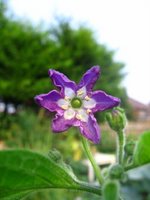The Magical 'Manzano' and the Pubescens species
 My Manzano plant is probably the favourite of the 70 odd varieties I’m growing out this year. I purchased a small plant from the 2005 Chilli Fiesta and successfully over wintered the plant in the back bedroom. After a slow start to the growing season, it has been storming ahead in recent weeks and after producing nearly 100 stunning purple flowers in early June, small apple like pods have started to appear. They look fab!!!
My Manzano plant is probably the favourite of the 70 odd varieties I’m growing out this year. I purchased a small plant from the 2005 Chilli Fiesta and successfully over wintered the plant in the back bedroom. After a slow start to the growing season, it has been storming ahead in recent weeks and after producing nearly 100 stunning purple flowers in early June, small apple like pods have started to appear. They look fab!!!Manzano meaning 'apple', originates from Mexico and is part of the species capsicum pubescens. Like its Peruvian & Bolivian cousins the Rocoto and Locoto, the plants can be fussy growers. Seeds can be slow to germinate and plants prefer dapple shade and a temperature range of between 60- 75oF rather than hot humid conditions. Mature plants have a better resistance to lower temperatures (not hard frosts) than the other four domesticated chile species (the others being annuum, chinese, frutescens and baccatum) hence why they tend to over winter well. Pubescens is also the only domesticated Capsicum species with no wild form; however, two wild species ‘Cardenasii’ and ‘Eximium’ are closely related.

Pubescens are grown most widely today in the Andes from Chile to Colombia, mostly in small family plots. Plants tend to be large growing up to 8ft in perfect conditions (although 3ft is more normal) and have large hairy, oval shaped leaves and stunning flowers which stand erect on the plant. Flowers tend to have purple corollas and purple/white anthers and are amongst the most beautiful of all the chile species. Check out the chileman database for some stunning examples.
As well as their hairy leaves, another distinguishing feature of the Pubescens species is their unusual black seeds which are very hard (like apple pips) and should be removed before eating. In terms of seed production, pubescens do not cross pollinate readily with any of the four other domesticed chile species and therefore in theory all seeds produced by a Pubescens variety in a mixed garden will be 'true' and viable.
Fruits are generally apple or an elongated pear (peron) shaped are at their most tasty when eaten fresh and should be left on the plant until needed. They come in three broad types – Amarillo (orange), rojo (red) or canario (yellow) - an indication of their maturity colour. Immature fruits are green.
One of the joys of these plants is that the fruits produce a unique and complex blend of capasaicinoids (pungency compounds), causing some people to believe they are hotter than habaneros. In parts of the Americas they are referred to as ‘el mas picante de los picantes’ - the hottest of the hot. I can’t wait to find out!!


7 Comments:
It easy to see that you love the pubescens varieties, l.o.l.
Gonz
This comment has been removed by a blog administrator.
Smoke left that same message on my blog... What's up with that?
Mark, great article!
Any pics of this years' Nagas???
Tina Brooks, Peppermaster Hot Sauces
Hi Tina,
The Naga's are coming along nicely. I will be posting an update on the blog very shortly ;)
Hope your well
Mark
Thanks Mark,
Very helpful. Now fingers crossed.
I have three different C.Pubescens, six plants in all, three different spots in the garden.
Hopefully they survive a hot summer.
Cheers, Grub.
Very good!
A friend of mine told me to come here can find what I want, I come, did not let me down, I like these things, very meaningful!
Post a Comment
<< Home